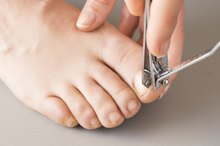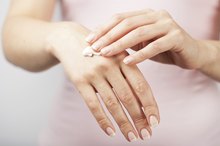What Are the Causes of Dry Cracked Hands?
Dry cracked hands may occur for a variety of reasons and cause pain or interfere with daily activities. Deep cracks are also vulnerable to potentially serious infections. Severely dry or cracked skin requires evaluation by a dermatologist to determine the underlying cause of the problem, according to the Mayo Clinic. This will ensure any underlying conditions are dealt with to prevent potential complications from developing.
Frequent Use of Harsh Soaps
Washing your hands too frequently or using harsh soaps can quickly dry out your skin. And washing your hands with hot water can make dryness and cracking worse by removing your skin's protective oils, according to the University of Iowa 3. To prevent and treat dry cracked hands associated with harsh soaps or washing too often, wear gloves when washing dishes -- and use a mild, moisturizing soap designed specifically for dry skin.
Contact Allergies
Symptom of Peeling Skin on Hands
Learn More
Contact with allergens can trigger dryness, redness, inflammation and other symptoms. This condition, called contact dermatitis, affects people of all ages and may cause:
- delayed symptoms
- according to American Academy of Allergy
- Asthma
- Immunology 2
Common causes of contact dermatitis include cleaning products, nickel and other metals, cosmetics and latex. Wearing gloves while cleaning and avoiding exposure to any substance that causes a flare-up in symptoms can prevent and treat dry cracked hands. The American Osteopathic College of Dermatology warns that continued contact with allergens can make symptoms more severe.
- Contact with allergens can trigger dryness, redness, inflammation and other symptoms.
- The American Osteopathic College of Dermatology warns that continued contact with allergens can make symptoms more severe.
Eczema
Eczema is a chronic disorder of the immune system that causes scaly, itchy patches of skin on the hands. Cracked, painful skin may develop in severe cases, according to the National Eczema Association 1. The American Academy of Dermatology states that more than half of people with eczema will develop symptoms on their hands during adulthood 2. Treatment of hand eczema generally involves lifestyle changes, frequent moisturizing with oil-based ointments and applications of topical hydrocortisone cream.
- Eczema is a chronic disorder of the immune system that causes scaly, itchy patches of skin on the hands.
- Treatment of hand eczema generally involves lifestyle changes, frequent moisturizing with oil-based ointments and applications of topical hydrocortisone cream.
Low Environmental Humidity
How to Treat Cracked Skin on the Hands
Learn More
Dry skin is more common during winter months when low outdoor humidity and indoor heating systems rob the skin of moisture, according to the University of Iowa 3. The hands are often severely affected because they are more frequently exposed to harsh weather conditions and dry air than other parts of the body such as the legs. When hands become severely dry, cracking, itching and pain may develop. Keeping the hands covered, applying moisturizer to dry patches and treating cracks as soon as possible with topical antibiotics can prevent and treat dryness and reduce the risk of infection and other complications.
- Dry skin is more common during winter months when low outdoor humidity and indoor heating systems rob the skin of moisture, according to the University of Iowa 3.
- Keeping the hands covered, applying moisturizer to dry patches and treating cracks as soon as possible with topical antibiotics can prevent and treat dryness and reduce the risk of infection and other complications.
Other Causes of Dry Cracked Hands
Hypothyroidism and some other disorders that cause hormonal imbalances can lead to dryness and cracking of the skin in some cases, according to the University of Iowa 3. Psoriasis, a chronic skin condition, can also cause dryness, flaking and cracking of the skin. This skin disorder is caused by abnormal activity of white blood cells, called T lymphocytes, according to the Mayo Clinic. Treatment typically involves light therapy or medication.
- Hypothyroidism and some other disorders that cause hormonal imbalances can lead to dryness and cracking of the skin in some cases, according to the University of Iowa 3.
Related Articles
References
- National Eczema Association: Hand Eczema
- American Academy of Dermatology: Eczema/Atopic Dermatitis
- University of Iowa: Winter Dry Skin
- QuickCare.org: Rashes and Skin Allergies
- Christoffers WA, Coenraads PJ, Svensson Å, Diepgen TL, Dickinson-Blok JL, Xia J, et al. Interventions for hand eczema. Cochrane Database Syst Rev. 2019 Apr 26;4:CD004055. doi: 10.1002/14651858.CD004055.pub2.
- Oosterhaven JAF, Voorberg AN, Romeijn GLE, de Bruin-Weller MS, Schuttelaar MLA. Effect of dupilumab on hand eczema in patients with atopic dermatitis: An observational study. J Dermatol. 2019 Jun 12. doi: 10.1111/1346-8138.14982. [Epub ahead of print]
- Christoffers WA, Coenraads PJ, Svensson Å, Diepgen TL, Dickinson-Blok JL, Xia J, et al. Interventions for hand eczema. Cochrane Database Syst Rev. 2019 Apr 26;4:CD004055. doi: 10.1002/14651858.CD004055.pub2.
- Oosterhaven JAF, Voorberg AN, Romeijn GLE, de Bruin-Weller MS, Schuttelaar MLA. Effect of dupilumab on hand eczema in patients with atopic dermatitis: An observational study. J Dermatol. 2019 Jun 12. doi: 10.1111/1346-8138.14982. [Epub ahead of print]
- Christoffers WA, Coenraads PJ, Svensson Å, Diepgen TL, Dickinson-Blok JL, Xia J, et al. Interventions for hand eczema. Cochrane Database Syst Rev. 2019 Apr 26;4:CD004055. doi: 10.1002/14651858.CD004055.pub2.
- Oosterhaven JAF, Voorberg AN, Romeijn GLE, de Bruin-Weller MS, Schuttelaar MLA. Effect of dupilumab on hand eczema in patients with atopic dermatitis: An observational study. J Dermatol. 2019 Jun 12. doi: 10.1111/1346-8138.14982. [Epub ahead of print]
- Christoffers WA, Coenraads PJ, Svensson Å, Diepgen TL, Dickinson-Blok JL, Xia J, et al. Interventions for hand eczema. Cochrane Database Syst Rev. 2019 Apr 26;4:CD004055. doi: 10.1002/14651858.CD004055.pub2.
- Oosterhaven JAF, Voorberg AN, Romeijn GLE, de Bruin-Weller MS, Schuttelaar MLA. Effect of dupilumab on hand eczema in patients with atopic dermatitis: An observational study. J Dermatol. 2019 Jun 12. doi: 10.1111/1346-8138.14982. [Epub ahead of print]
Writer Bio
Sandra Ketcham has nearly two decades of experience writing and editing for major websites and magazines. Her work appears in numerous web and print publications, including "The Atlanta Journal-Constitution," "The Tampa Bay Times," Visit Florida, "USA Today," AOL's Gadling and "Kraze Magazine."








